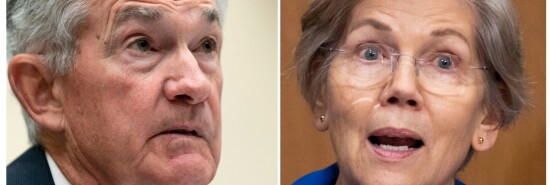
Elizabeth Warren whines, but the job market is way too hot for the Fed’s dual mandate
Tiana Lowe Doescher
Video Embed
Although the Federal Reserve quietly removed its forward guidance from its latest announcement that it would raise interest rates by another 25 basis points, job growth continues to come in way too hot to assume that the central bank will not raise rates at least once more during the year.
And contrary to the whines of Sen. Elizabeth Warren, who has once again browbeaten Fed Chairman Jerome Powell for trying to crack down on inflation, the employment half of the Fed’s dual mandate remains not just upheld, but perhaps even prioritized.
DOZENS OF SCHOOL DISTRICTS EMBRACE ‘EQUITABLE GRADING,’ SETTING UP STUDENTS FOR FAILURE
Employment rose by more than half a million jobs in April, blowing past the expectation of 185,000 jobs. While the Bureau of Labor Statistics revised March employment gains downwards, April’s unemployment rate held at 3.4%, a 54-year low. Nominal wage growth increased to 4.4%.
Of course, stubbornly persistent inflation — even core PCE, the Fed’s preferred inflation, which usually clocks in much lower than headline inflation, remains at 4.6% — means that real wages have actually been in free fall since the worst inflation in 40 years started in 2021.
Although the fastest rate hike campaign in Fed history has brought the nominal federal funds rate to the 5% to 5.25% range (meaning that real interest rates are finally positive, per the Fisher equation), the Fed is still only fulfilling one-half of its dual mandate.
And despite Warren’s wailing to the contrary, the Fed is still only achieving full employment, not price stability.
On top of inflation itself, which remains nearly three times the Fed’s maximum target of 2% annually, the job market is way too hot for the Fed, which doggedly adheres to the Phillips Curve in its modeling. While an increase in the labor force participation rate — that is, the denominator of the unemployment quotient — could ameliorate inflation by contributing to the supply side of the equation, the ultra-tight unemployment rate, by definition, puts upward pressure on wages, worsening the risk of a wage-price spiral, without adding supply to meet the heightened consumer demand driving the post-pandemic economy.
Although politicians and economists scoff at Powell’s insistence that a soft landing is possible in the long run, the employment data gives the Fed the cover in the short run to raise rates at least once or twice more this year.
While the consequences of monetary policy do have a lag time, the May FOMC meeting marked 14 months since the start of the Fed’s hiking cycle. If the Fed restoring interest rates to their half-century average hasn’t brought ruinous consequences to the labor force just yet, it is fully possible that the “soft landing” in theory may be a mere “ever-so-slightly hard” landing in practice.
CLICK HERE TO READ MORE FROM THE WASHINGTON EXAMINER
The markets are still continuing their sugar rush from their misguided interpretation of the Fed removing its forward guidance. By Friday’s opening bell, Fed futures investors are pricing in a one-in-three chance of a rate cut from the Fed’s July meeting. By the September meeting, investors have priced in a staggering 79% of a rate cut.
But even after all these hikes, the Fed is still only fulfilling its mandate of full employment, not bringing about price stability. With April’s jobs report, the Fed has the green light to defy Wall Street and continue its war against inflation.
